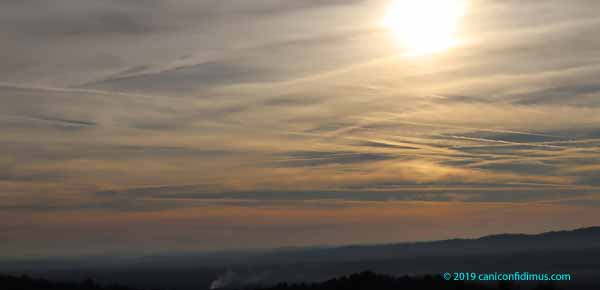We live about 70 or 80 miles northwest of the Atlanta airport, as the crow or airliner flies, so we see a fair amount of air traffic. Passenger jets are usually still pretty high when they pass over us, so we often don’t see the airplane, only the contrail.
A few days ago the conditions were right for contrails.

Sometimes if the air is dry, contrails don’t last long. If there is more humidity at airliner altitude, the fine particles in a jet engine’s exhaust can become condensation nuclei for water vapor, and the contrails grow.
We can also often see smoke clouds. When people clear land they sometimes make big piles of trees that they burn (with the appropriate permit). This was a particularly big and long-lasting burn.

The smoke from this fire did not rise to any great altitude. In fact, it brushed the ground downwind from the fire. In air pollution meteorology, this is known as fumigating. If you have ever seen what we used to call a smoke stack at a factory or coal-burning power plant, you might have noticed how tall it is. That height is a result of a calculation made by the owners. The calculation yields a stack height that will prevent regulated pollutants from reaching a prohibited concentration on the ground downwind from the stack under most atmospheric conditions. The further downwind a smoke plume goes, the more it spreads out, both vertically and horizontally. As it spreads, the plume is diluted and the concentration of pollutants decreases. So, the stack must be tall enough that the plume is diluted enough that the pollutant concentration is below regulated standards before it reaches the ground.
If there is a strong temperature inversion, the atmosphere forms a kind of cap, so sometimes a smoke plume doesn’t rise very high. In that kind of case, the plume might reach the ground before it is diluted enough. That’s fumigation, and that is apparently what happened with the fire in this photo.
Of course, the smoke from this fire didn’t get ejected from a tall stack, it just rose from the fire. The heat of the fire is often enough to get the plume high into the atmosphere to prevent what happened here. Not so this time. So people downwind from this fire probably had a pretty unpleasant day.
Or, as it turned out, an unpleasant several days. I took this photo on December 20. On the morning of December 29, the day I wrote this, there was still a little smoke coming from this fire.
I asked John, our grader neighbor, if he knew what the source might be. He thought it came from a privately-owned dump, where John disposed of the trees he took when clearing our lot. The owner piles the trees and occasionally burns them.
Anyone burning large quantities of vegetation requires a different permit from the one I get when I burn limbs I collect from our yard. Depending on certain conditions that I’m not familiar with, large-scale burning might require the use of an air curtain destructor or incinerator. This equipment is supposed to contain smoke until it is burned, which is supposed to reduce or eliminate smoke. This burn apparently did not use one.
When the man cleared the valley for what would become my lake, he burned the tree piles, and he added old tires to them to make them burn hotter/faster. The smoke was black. And this being the Ozarks, I’m sure no permit was collected.
I read that Edward Abbey would take old tires up into the dormant volcanoes around Santa Fe and set them ablaze, then tell everyone the volcanoes were coming back to life.
I didn’t know there was so much regulation on burning vegetation, but that’s probably because we don’t have any vegetation to burn. I know in California there are seasonal regulations because of the very high large forest fire dangers.
Paul — My friend Tom who lives outside of Albuquerque talked about someone (Abbey?) lighting tires in the extinct volcanoes and causing a lot of excitement among the younger, more naive reporters at the local news outlets.
Robin — We are in an area with a burn ban that lasts over the warmer months. It’s in place because of Atlanta’s air quality. Wild fires have not been much of a problem here, although there have been some pretty serious fires in the last few years. Nothing like California, so far.